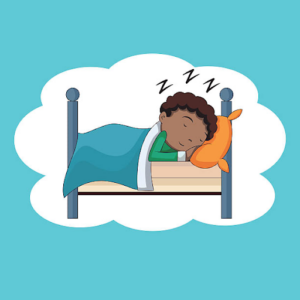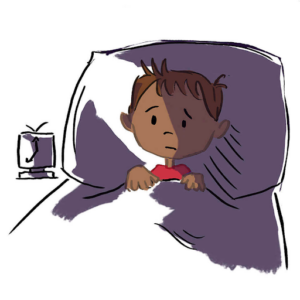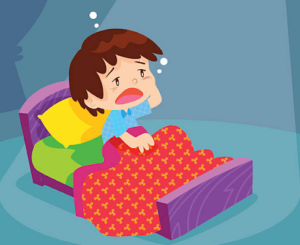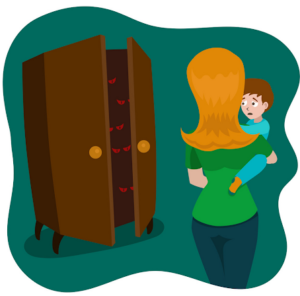
As adults, we have all been there, it is past your “bedtime,” you are wide-eyed, staring at your ceiling and your thoughts are racing. The time flies by as you intermittently check your clock and countdown the hours until your alarm goes off in the morning, but something in you just will not let you fall asleep. Did you know that kids can experience the same type of nighttime anxiety that keeps them awake? They may not be able to identify their resistance to falling asleep as “anxiety” but parents and caregivers can teach their kids the tools they need to understand what is keeping them awake and how to address it.
Environmental Triggers
 When addressing nighttime anxiety, a good first rule of thumb is to target environmental triggers that might encourage your child to stay alert/awake. Have they been off of a screen for approximately an hour? Are the blinds fully closed? Are all the lights off? Do they have their comfort items nearby (teddy bears, blankies, etc.)? If you responded yes to all of these questions, you may want to try adding additional calming environmental factors. An anxious brain has a harder time filtering out non-important sounds and smells (such as a car driving past the house, or a strong candle burning in another room). This makes it more likely for the brain to be alerted and awaken at night, so setting your child up for success may involve adding a sound machine with white noise or a turning on a diffuser that releases lavender or neroli oil.
When addressing nighttime anxiety, a good first rule of thumb is to target environmental triggers that might encourage your child to stay alert/awake. Have they been off of a screen for approximately an hour? Are the blinds fully closed? Are all the lights off? Do they have their comfort items nearby (teddy bears, blankies, etc.)? If you responded yes to all of these questions, you may want to try adding additional calming environmental factors. An anxious brain has a harder time filtering out non-important sounds and smells (such as a car driving past the house, or a strong candle burning in another room). This makes it more likely for the brain to be alerted and awaken at night, so setting your child up for success may involve adding a sound machine with white noise or a turning on a diffuser that releases lavender or neroli oil.
 Body Regulation
Body Regulation
Another factor to consider that often goes under the radar when it comes to healthy sleep habits is body regulation. Adults sometimes feel so anxious that it feels like they could jump out of their own bodies. Kids feel that too! A great way to get your child’s body ready for bed is by implementing sensory activities about an hour before bedtime. These might include: bear walks down a long hallway, pulling a weighted blanket a few times up and downstairs, doing full body crashes onto a couch or into their bed, etc. In addition to these, you also want to add a relaxing sensory activity when you lay your child down for bed. This might include deep tight squeezes on their body from head to toe (like a massage) and you can also add lavender or neroli infused lotion to assist in calming their olfactory nerves. All are great ways to encourage their body to maintain a calm state throughout the night!
Thinking Tools
 Since anxiety can often involve a loop of racing thoughts, it is also important to empathize with your child and rationalize those anxious thought patterns. Are they nervous about school the next day? Remind them how safe they are in the moment and that they will be just as safe at school. Are they worried about a monster in the room? Explain to them that monsters are not real and you can even do a “monster scan” to disprove the thought even further. Are they worried about separating from a caregiver? Place a photo of the caregiver on the wall or nightstand next to them and remind the child that they can always look at the picture if they feel lonely or scared. Regardless of what the thought may be, rationalizing it in the moment can keep your child from letting it spiral out of their control.
Since anxiety can often involve a loop of racing thoughts, it is also important to empathize with your child and rationalize those anxious thought patterns. Are they nervous about school the next day? Remind them how safe they are in the moment and that they will be just as safe at school. Are they worried about a monster in the room? Explain to them that monsters are not real and you can even do a “monster scan” to disprove the thought even further. Are they worried about separating from a caregiver? Place a photo of the caregiver on the wall or nightstand next to them and remind the child that they can always look at the picture if they feel lonely or scared. Regardless of what the thought may be, rationalizing it in the moment can keep your child from letting it spiral out of their control.
Put the Worries to Bed
Sleep disturbances are often more exhausting for the caregivers navigating them than for the children themselves but it is possible to help your child achieve healthier and restful sleep! With consistent practice and implementation of these strategies you can set your child up (and yourself!) for a successful night’s rest.

Questions or concerns?
If you have questions or concerns about your child’s sleeping habits, please contact us at info@playworkschicago.com or 773-332-9439.
Melissa Svec, LSW
Licensed Social Worker
Resources:
Arky, B. (2021, August 25). How to help kids who have trouble sleeping. Child Mind Institute. Retrieved April 18, 2022, from https://childmind.org/article/how-to-help-kids-sleep/
Pacheco, D. (2022, April 15). Sleep strategies for children. Sleep Foundation. Retrieved April 18, 2022, from https://www.sleepfoundation.org/children-and-sleep/sleep-strategies-kids
